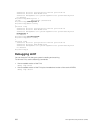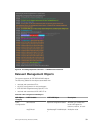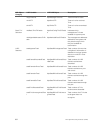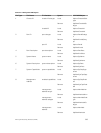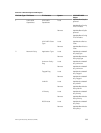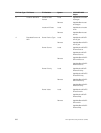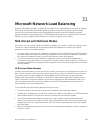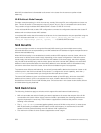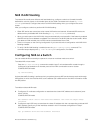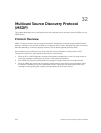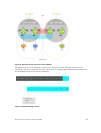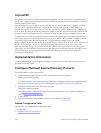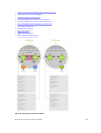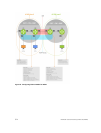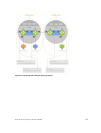With NLB, the data frame is forwarded to all servers in the cluster for the servers to perform load-
balancing.
NLB Multicast Mode Example
Consider a sample topology in which four servers, namely S1 through S4, are configured as a cluster or a
farm. This set of servers is connected to a Layer 3 switch, which in turn is connected to the end-clients.
They contain a single multicast MAC address (MAC-Cluster: 03-00-5E-11-11-11).
In the multicast NLB mode, a static ARP configuration command is configured to associate the cluster IP
address with a multicast cluster MAC address.
In multicast NLB mode, data is forwarded to all servers in the cluster based on the port specified using the
Layer 2 multicast command: mac-address-table static <multicast_mac> multicast vlan
<vlan_id> output-range <port1>, <port2>, ... in CONFIGURATION mode.
NLB Benefits
You must configure a switch to recognize Microsoft NLB clustering so that multiple servers using
Microsoft Windows can be represented by one MAC address and IP address to support transparent server
failover and load-balancing.
When NLB functionality is not enabled and a switch sends an ARP request to a server cluster, either the
active server or all the servers send a reply, depending on the cluster configuration. If the active server
sends a reply, the switch learns the active server’s MAC address. If all servers reply, the switch registers
only the last received ARP reply, and the switch learns one server’s actual MAC address; the virtual MAC
address is never learned. Because the virtual MAC address is never learned, traffic is forwarded to only
one server rather than the entire cluster; server failover and balancing are not supported.
To preserve server failover and balancing, the switch forwards traffic destined to the server cluster on all
member ports in the VLAN connected to the cluster. To configure this switch capability, enter the ip
vlan-flooding command when you configure the Microsoft server cluster.
The server MAC address is given in the Ethernet frame header of the ARP reply, while the virtual MAC
address of the cluster is given in the payload. As a result, all traffic destined for the server cluster is
flooded from the switch on all VLAN member ports. Since all servers in the cluster receive traffic, failover
and load-balancing are preserved.
NLB Restrictions
The following limitations apply to switches which support Microsoft network load balancing.
• NLB unicast mode uses switch flooding to transmit packets to all servers that are part of the VLAN
connected to the cluster. When a large volume of traffic is processed, the clustering performance
might be impacted in a small way. This limitation is applicable to switches that perform unicast
flooding in the software.
• The ip vlan-flooding command applies globally across all VLANs on the switch. In cases where
NLB VLAN flooding is enabled and ARP replies contain a discrepancy in the Ethernet SA and ARP
header SA frames, packet flooding over the relevant VLAN is performed.
• The maximum number of server clusters supported at a time is eight.
568
Microsoft Network Load Balancing



